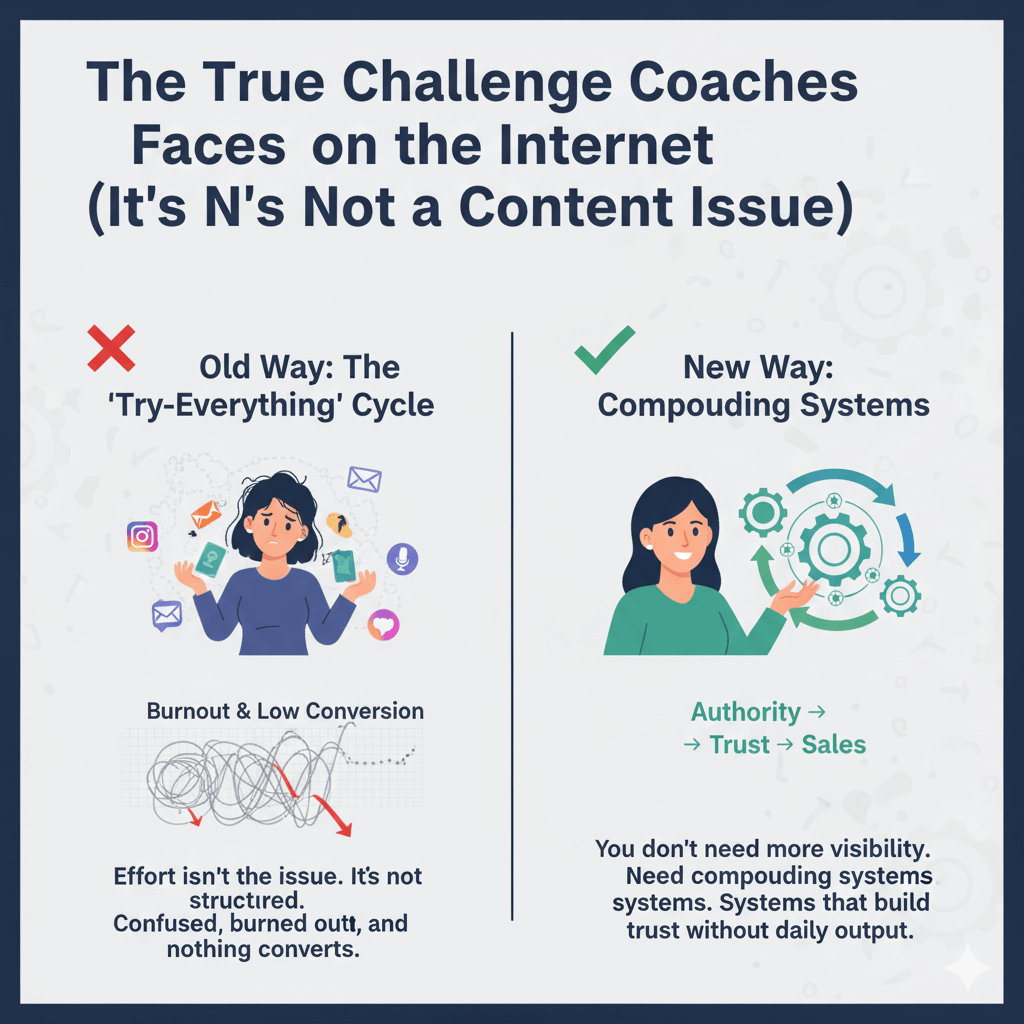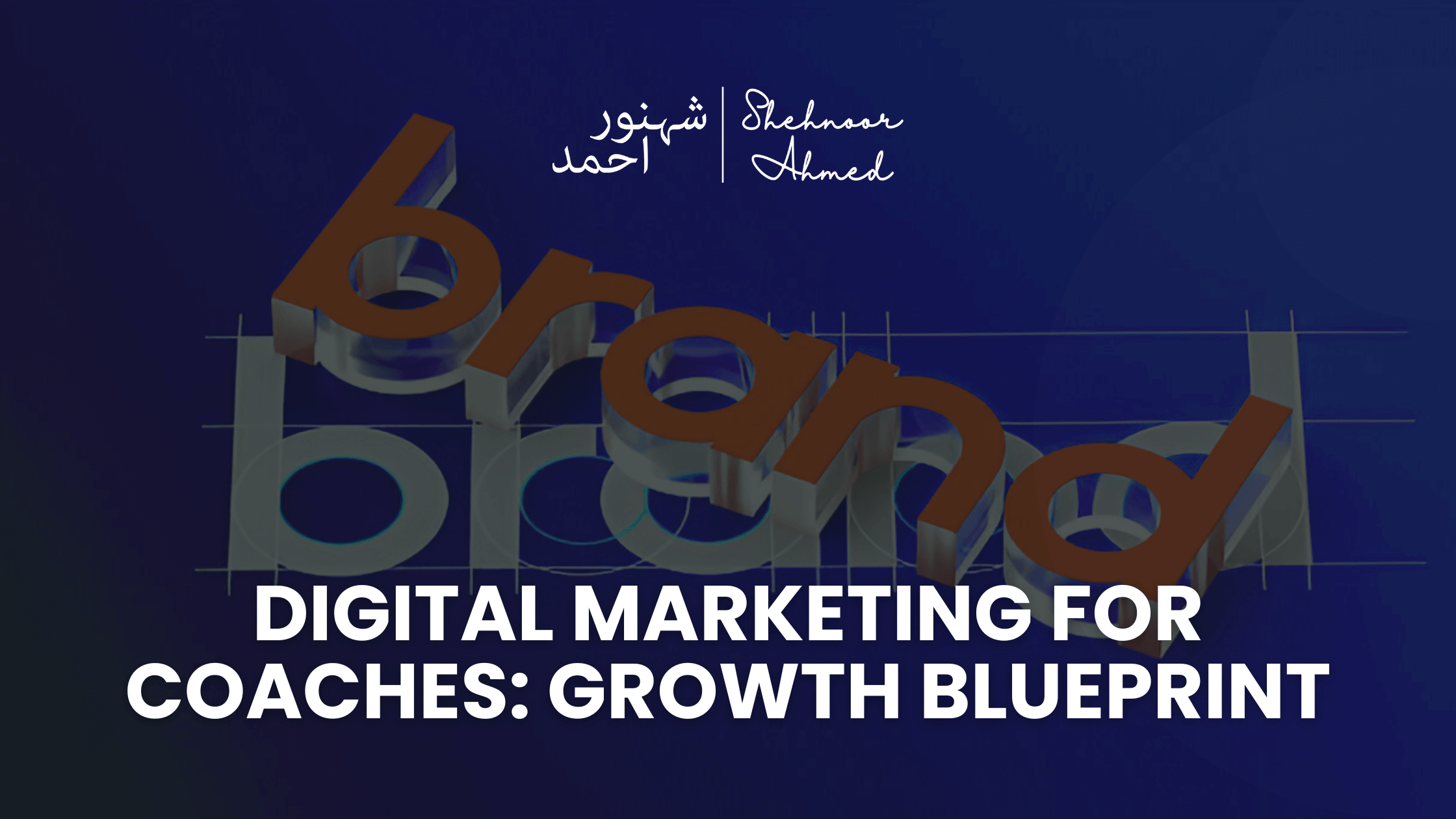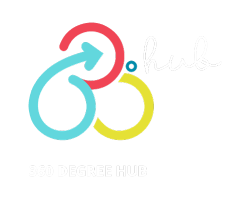It is no longer effective to post daily in the hopes of generating leads. You are aware of that already. You have adhered to trends, maintained consistency, and perhaps even increased your output of “value” content. However, what is the reality? Unless it is a component of a system, more content does not equate to more clients. I use this exact Blue Print of digital marketing for Coaches to build brands. This system has worked across coaching niches, fitness, career, trauma recovery, and mindset, to produce genuine growth without the burnout, from establishing authority to converting strangers into scheduled calls.
The True Challenge Coaches Face on the Internet (It’s Not a Content Issue)

Most coaches aren’t erratic. In reality, they’re doing a lot, reels, email newsletters, Instagram posts, and they’re running into problems.
- Effort isn’t the issue.
- It isn’t structured.
- Burned out, perplexed, and wondering why nothing is converting, the majority of coaches are caught in the “try-everything” cycle.
More visibility is not necessary for you. Compounding systems are what you need.
Systems that, without requiring daily output, establish authority, foster trust, and turn attention into sales.
The Marketing Road Map That Works Well for Brand Coaching
This is the precise sequence I adhere to when working with clients: it is straightforward, strategic, and growth-oriented.
Step 1: Establishing the Offer and Defining the Niche
We start by defining the niche and proposing to solve a significant, urgent problem. No more vague promises that you will “unlock your potential” or “transform your life.”
The fitness instructor I work with changed from “general body coaching” to “performance coaching for startup startups.” Findings? The number of consultations in 60 days is four times greater.
Why this works in 2025:
Search engines and social audiences respond to specificity and authority.
Step 2: SEO and Relevant Authority
We create content clusters based on real problems that your audience is already searching for. This is not about stuffing your page with keywords; it’s about demonstrating to search engines (and people) that you are an authority on a subject. A trauma recovery coach’s twelve content pieces were organised around a single transformation. These days, three regularly produce traffic and leads each day.
Why is this effective in 2025?
Search engines favour deep, structured expertise over random advice or surface-level content.
Step 3: Content Pillars + Repurposing Strategy
We choose three or four content pillars, start with video content, and then adapt it to other formats and platforms.
An Instagram reel, carousel, blog excerpt, newsletter, or short post can all be made in a single video.
A leadership coach did this every week, and in forty-five days, the number of scheduled calls quadrupled.
Why is this effective?
You create more touchpoints without doubling your workload. Reuse scales trust.
Step 4: Lead Magnet + Funnel System
We create a lead magnet that solves urgent problems and link it to a funnel that plans discovery calls automatically.
Not some vague “free eBooks,” The lead magnet must provide clear value on time. Think of a toolkit, quick guide, or checklist.
In 30 days, a career coach added 52 scheduled calls using this system.
Why this works:
Traffic is a missed opportunity in the absence of a funnel. Your audience is given a next step when you use a lead magnet.
Step 5: System of Conversion and Enrichment
The individual who has opted in receives a well-structured email series designed to build trust and promote conversion.
This isn’t spam. Education, objection handling, and intelligent storytelling are all automatically supplied.
Client conversion increased by 38% for a coach who employed a five-email nurture flow.
Why this is effective:
People are not converted by a single post. However, consistent follow-up builds momentum and trust.
In 2025, SEO for Coaches
As if it were 2015, most coaches still write generic blog posts and include keywords in their content.
That’s the end of it.
Today, the secret to success is building authority around key themes.
This comprises: One change
- Increasing depth instead of merely volume
- Writing for readers who need clarity rather than search engines
For instance:
For example, instead of writing twelve flimsy “mindset hacks,” you plan a series of content around:
- Burnout among high performers
- Unknown causes of procrastination
- Mentality reframes backed by client testimonials
Why this works:
On search platforms, topical depth, structure, and clarity are prioritised over noise.
Where to Direct Your Energy
Being everywhere wears you out. Here’s how to concentrate:
- YouTube (both short and long): Long-term value and visibility
- LinkedIn or Instagram: Interaction and establishing connections
- Email funnel: Obtaining and converting leads
The path you’re creating:
Stranger → Useful content → Nurture → Discovery call
This is a system, not a theory.
The Things That Most Coaches Should Do Instead of Wasting Time
What doesn’t work is this:
- posting every day without any offers
- Creating blogs without a strategy for content
- Making videos without a clear call to action
- Steer clear of funnels since they “feel too corporate.”
This is what it does:
- Unambiguous, niche-specific messaging
- Clusters of strategic content
- One priceless lead magnet
- Repurposed, consistent video
- Easy-to-use, automated follow-up
Tools that I suggest (and how to use them)
Although they are not necessary, these tools can make your work go more quickly:
Idea: Map out topic clusters and schedule your weekly content.
ConvertKit/Systeme: Create and oversee email funnels and sequences
Semrush: Examine search trends and topic gaps
Loom and Descript: Fast video production without a studio
Instead of replacing the strategy, use tools to support it. Thought is still more important than technology.
Click to know which tool I use for Digital Marketing and why, here is the simple comparison between SEMrush vs Ahrefs.

Real Results from Brand Coaching
Fitness Coach
Refined the niche and created a simple Instagram funnel.
The number of subscribers rose from 300 to 4,000 in just three months.
Trauma Coach
Created content clusters with a single topic at their core.
Ranks first for five daily client enquiries that result in leads.
Leadership Coach
One video is repurposed for four distinct platforms each week.
The quantity of discovery calls rose in just six weeks.
Summary Phase of the Coaching Blueprint Phase
Why It Works and What We Do
Final Words:
This is your roadmap if you’re tired of confusion, burnout, and low conversions. Installing smarter systems is more important than working harder. Being everywhere isn’t the goal of marketing in 2025. It’s about establishing a compounding system, taking control of your space, and strategically showing up.
Do you need assistance starting from scratch?
Contact me at hello@shehnoorahmed.com or book 1:1 consultancy.

FAQs:
What should a new coach do right away?
Determine the niche and develop a lead magnet for a single, excruciating issue.
How long does it take to see results from SEO?
With structured topics, the majority of coaches observe a noticeable increase in traffic within 60 to 90 days.
YouTube, LinkedIn, or Instagram?
Consider your audience when making your choice. Instagram or LinkedIn + YouTube Shorts are beneficial for the majority of coaching clients.
Does growing require paid advertising?
No. Organic systems can produce consistent leads and sales.
Which kind of lead magnet is best?
Checklists, templates, or brief guides that are concise, useful, and results-oriented.
Should I create a webinar or a newsletter?
Start with an email flow and a lead magnet. Later webinars can increase conversions.
Is it still worthwhile to blog?
Yes, provided that content clusters are strategically used under client needs.




